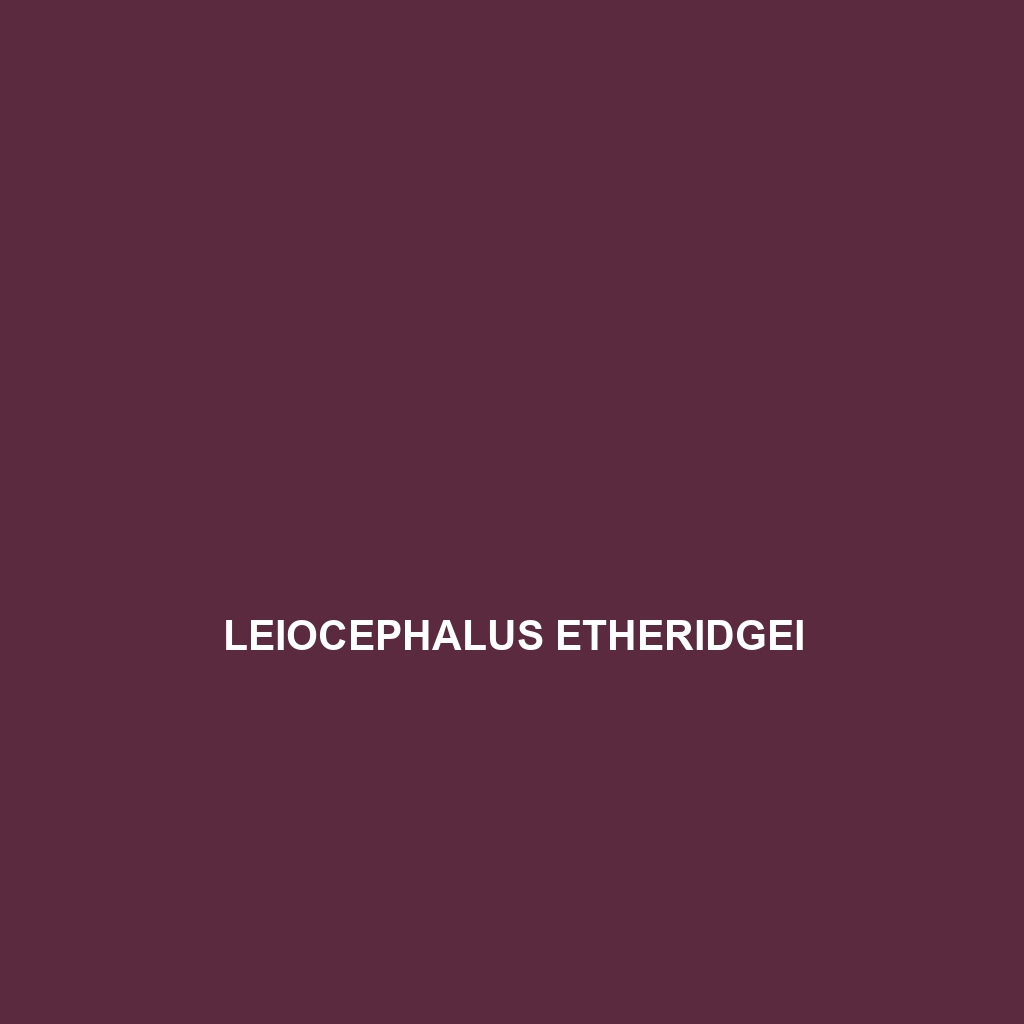Common Name
Leiocephalus etheridgei
Scientific Name
Leiocephalus etheridgei
Habitat
Leiocephalus etheridgei, commonly known as Etheridge’s Curly-tail Lizard, is primarily found in the tropical and subtropical regions of the Caribbean, specifically on the islands of the Bahamas. This species thrives in diverse habitats such as woodlands, savannas, and coastal areas. The lizard prefers environments with abundant vegetation and access to sandy soils, which provide ideal conditions for burrowing and hunting. These habitats often experience warm temperatures and seasonal rainfall, making them suitable for the growth of various plant species, particularly shrubs and grasses. The presence of sunlit areas within these habitats is crucial for basking and thermoregulation, as Leiocephalus etheridgei is ectothermic and relies on external heat sources.
Physical Characteristics
Leiocephalus etheridgei exhibits distinctive physical characteristics that set it apart from other lizard species. Typically, adults reach a length of about 15 to 25 centimeters (6 to 10 inches). They possess a robust body, a long tail, and a flattened head, which aids in their burrowing and navigating through dense vegetation. The coloration of Leiocephalus etheridgei varies, often featuring a combination of brown, gray, and olive hues, with darker bands or spots that provide camouflage against predators in their natural environment. Their skin texture is rough and scaly, which helps retain moisture and protect against abrasions. Notably, they possess long, sharp claws that facilitate digging and climbing.
Behavior
The behavior of Leiocephalus etheridgei is characterized by territoriality and a predominantly diurnal lifestyle. These lizards are known for their agility and can often be seen basking in the sun or quickly darting into shrubs when threatened. During the mating season, males exhibit aggressive behaviors, including head-bobbing displays and push-ups to establish dominance and attract females. Although primarily terrestrial, they are capable climbers, often ascending trees and bushes to forage or escape predators. Interestingly, these lizards display a degree of social interaction, especially during mating rituals, where pheromones play a crucial role in signaling readiness to mate.
Diet
Leiocephalus etheridgei is primarily insectivorous, feeding on a diet that consists mainly of insects such as ants, beetles, and grasshoppers. They are opportunistic feeders and may also consume plant matter, including fallen fruits and leaves, classifying them as an omnivorous species. Their hunting techniques involve stalking and ambushing prey, utilizing their speed and agility to capture fast-moving insects. During times of food scarcity, these lizards can adapt their feeding habits, showcasing their resilience in fluctuating environmental conditions.
Reproduction
The reproduction of Leiocephalus etheridgei occurs during the warmer months, specifically from late spring to early summer. Mating rituals involve elaborate courtship displays, where males compete for female attention through visual displays and territorial defense. Once mated, females lay clutches of approximately 4 to 8 eggs buried in sandy substrates, which provide protection from potential predators. The eggs typically incubate for about 60 to 80 days before hatching. After emerging, the juveniles are independent and receive no parental care, which is common among many lizard species. This strategy enhances their survival chances as they quickly adapt to the environment.
Conservation Status
According to the International Union for Conservation of Nature (IUCN), Leiocephalus etheridgei is currently classified as ‘Least Concern.’ However, local populations may face threats from habitat destruction due to urban development, invasive species, and environmental changes. Conservation efforts are essential to monitor and protect their habitat, ensuring the species continues to thrive in its native range. Engaging local communities in conservation awareness is crucial to mitigate potential threats and maintain healthy ecosystems.
Interesting Facts
Leiocephalus etheridgei displays several fascinating traits that captivate researchers and lizard enthusiasts alike. One such characteristic is their remarkable ability to adapt to changing environmental conditions, which is a significant factor contributing to their survival in various habitats. Additionally, these lizards are known for their unique defensive behavior; when threatened, they may emit a loud hiss as a warning to potential predators, discouraging them from pursuing. Their fascinating courtship displays and territorial behaviors also contribute to their social complexity.
Role in Ecosystem
As both predator and prey, Leiocephalus etheridgei plays a vital ecological role in its habitat. By preying on insects, they help control pest populations, contributing to the overall balance of the ecosystem. Additionally, these lizards serve as a food source for larger predators, including birds and snakes, which highlights their importance within the food web. Their activities also aid in seed dispersal, especially when consuming fruits, thereby promoting plant diversity and health within their environment. As such, the conservation of Leiocephalus etheridgei is essential not only for their survival but also for maintaining the integrity of the ecosystems they inhabit.
